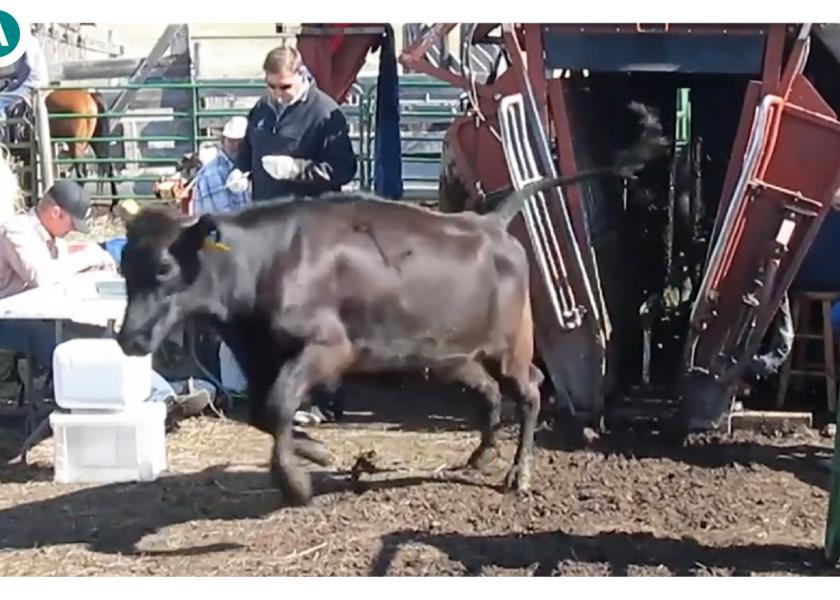Squeeze Chute Work

In this article we will discuss eight ingredients for successful, low-stress squeeze chute operation. This is important because research has shown cattle that become agitated in the squeeze chute have tougher meat and more dark cutters, and up to 40% of administered vaccines won’t be effective. Also, as exit velocity increases, the number of days cattle are treated for sickness increases and average daily gains decrease. Not to mention that agitated cattle in confined situations are a danger to themselves and people.
Conventionally, people often have difficulty getting their cattle into the squeeze chute, and once in they thrash around and run out when released (see Figure A, above).
None of this should happen when cattle are handled properly (i.e., brought up calmly and quietly by people with a good mindset and attitude who obey low-stress livestock handling principles and use good technique). Cattle should come into the squeeze chute calmly and willingly, stand there and walk out when released (see Figure B, below).

Figure B. During preg testing on this ranch, every cow walked out of the squeeze chute seemingly unconcerned about what it had just experienced.
Conventionally, people think cattle are afraid of the squeeze chute because of what was done to them in there in the past, and that’s why they balk. According to Bud Williams, “Livestock don’t remember bad things, they remember bad handling.” When handled properly, cattle do not mind going into a squeeze chute; it’s what we do to them beforehand that matters. Both authors have had the experience of processing the same animals numerous times in a short time (e.g., synchronized AI or chronically sick) and instead of getting worse to load into the squeeze chute — as conventionally happens — they got better.
Ingredients for Success
1 Minimize noise. Any personnel around the squeeze chute should minimize talking, and when they do, use only conversational tones. Also, all mechanical noise should be minimized such as hydraulic motors (see Figure C, below).

Figure C. The hydraulic motor for the squeeze chute was relocated outside of this squeeze chute house in an insulated compartment, which made it less stressful on both the animals and people.
2 Hold the caught animal until the next animal is ready to come in, then release it. The exiting animal serves as a draw for the entering animal.
3 Leave the headgate wide open until the next animal commits. The larger the opening and the more daylight, the more likely the animal is to see the way out and take it.
4 Slow animals down that are coming in too fast, either by (a) slightly squeezing them, or (b) closing the headgate a little as the animal enters. Either technique slows animals down, and allows the squeeze chute operator to more slowly close the headgate, both of which help avoid shoulder bruises and injuries.
5 When releasing, open the headgate first, then the sides. How we release a caught animal is important. Some operators have trouble with animals going backward — instead of forward — and not wanting to go out when the squeeze is opened. There are two reasons for this. First, the animal’s mind is going backward which could’ve been caused by mishandling at any stage of the processing presqueeze. Second, the sides are released before the headgate.
6 Don’t release the animal until it is calm. If we release an animal that is not calm (e.g., thrashing about) it reinforces that behavior so the cow is more likely to do it the next time. Once calm, release the sides slowly.
7 Don’t release the cow until you have the attention of the next cow. Sometimes the waiting cow is looking elsewhere (e.g., behind it at the other cattle or at a handler who’s out of position), so it will not see the released cow exit the squeeze. Hence, you lose the “power of the draw” (see Figure D, below).

Figure D. The squeeze chute operator waits until this animal’s attention is on the held animal before he releases it.
8 Use good stockmanship technique. Reverse-parallel and “in and out” can be used as needed to facilitate a reluctant animal exiting. Keep the endgate about three-quarters closed so if an animal does back up and stalls out against the endgate, you can gently pinch its tailhead.
De-stressing
When we work animals through the squeeze chute there’s a certain amount of stress put on them. Conventionally, this is of no concern, but from the low-stress perspective, that stress should be taken care of before we leave those animals or turn them out. We might do that by walking through them, or taking them for a short walk, or letting them come by us through a gate — something to reassure them everything is okay and to hit the reset button so they get back to a normal mental state.
Conclusion
By following these eight ingredients for success during our squeeze chute work we can turn what is often a high-stress experience for the cattle (and people) into a low-stress experience.
Whit Hibbard is a fourth- generation Montana rancher and the editor of Stockmanship Journal. (Stockmanshipjournal.com) Dawn Hnatow is Bud Williams’ senior student and manages two cattle ranches in Texas. (Cattleupstockmanship.com)







